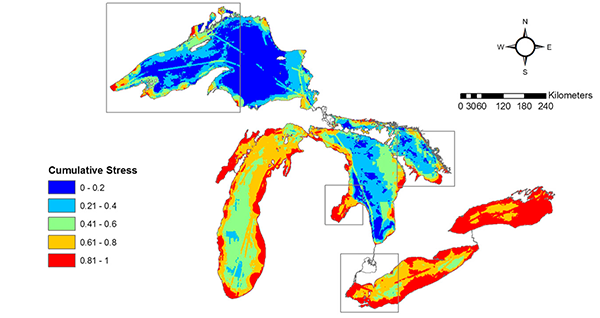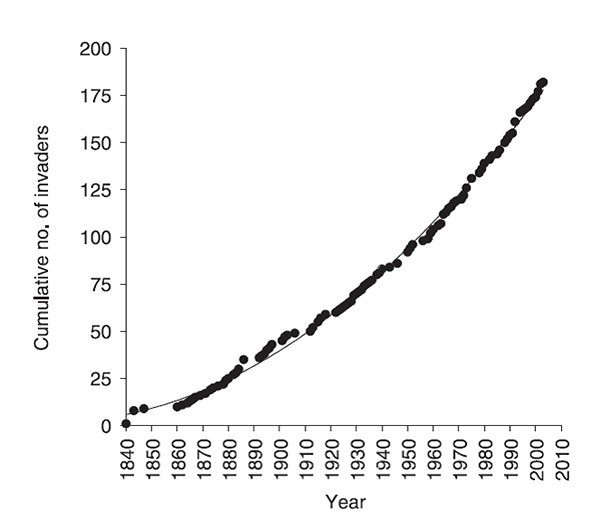Detroit River-Western Lake Erie Basin Indicator Project
Invasive Species
Authors
Dr. Hugh J. MacIsaac, University of Windsor, Great Lakes Institute for Environmental Research, hughm@uwindsor.caEmma M. De Roy, University of Windsor, Great Lakes Institute for Environmental Research, deroye@uwindsor.ca
Background
Numerous stressors threaten the health of the Laurentian Great Lakes in general, and Lake Erie in particular (Figure 1). The Great Lakes are replete with non-indigenous species (NIS), with over 180 species are currently established (Ricciardi, 2006) (Figure 2); Lake Erie supports the greatest number of AIS (USGS, 2012). Arguably, NIS that cause profound ecological and economic damage - invasive species – are the leading stressor in Lake Erie (Allan et al., 2013). Numerous pathways are responsible for NIS release including commercial shipping, live species trade, and unauthorized introductions (Ricciardi, 2006). Ballast water release from commercial shipping has been the primary pathway for species introductions since 1959 (Ricciardi, 2006).

Figure 1. Cumulative environmental stress experienced in each of the Great Lakes, including invasive species. Data are pooled from 34 total stressors (Allan et al., 2013).

Figure 2. Cumulative number of non-indigenous species in the Great Lakes (Ricciardi, 2006).
Status and Trends
The number of new NIS was seemingly reduced following mandatory ballast water flushing regulations for foreign ships entering the Great Lakes (Bailey et al., 2011). Despite this, four new invertebrate NIS (copepods Thermocyclops crassus and Mesocyclops pehpeiensis, cladoceran Diaphanosoma fluviatile and rotifer Brachionus leydigii) have been reported since 2014 in Lake Erie (Connolly et al., 2017; Connolly et al., 2018; Connolly et al., 2019; Lower and Sturtevant, 2019). Some of these NIS were reported previously in ship’s ballast water (Johengen et al., 2005), suggesting that they may have entered via this pathway. Mesocyclops is associated with aquaculture and the ornamental plant trade (Connolly et al., 2019). Alternative pathways – e.g., aquarium trade – also introduce species (Duggan et al., 2018) and, without proper management, are likely to dominate longer-term invasions in the Great Lakes as ballast water treatment becomes mandatory. Caution needs to be exercised in attribution of pathways when new NIS are reported, as the new NIS in Lake Erie could have entered prior to implementation of ballast water management even though they were discovered recently (i.e., time lags), or if more than one pathway could potentially introduce a species.
Management Next Steps
Coordinated NIS regulations and management are needed in this region. For example, intensive grass carp eradication is of utmost importance given their expanding range in the southern part of western Lake Erie, and the high risks associated with the species (Cudmore et al., 2016; Embke et al., 2016).
The IMO International Convention for the Control and Management of Ships’ Ballast Water and Sediments will require all vessels to have on-board water treatment systems by 2024, and places limits on the permissible abundance of discharged organisms (IMO, 2016). It is important that these regulations apply to the domestic ‘laker’ fleet as well to reduce inter-lake dispersal of NIS. In addition, the efficacy of ballast treatment should be verified through comprehensive sampling on the Great Lakes. Enactment of regulations relevant to alternative pathways also requires immediate attention region-wide.
Research/Monitoring Needs
Species-specific methods of control and impact mitigation are needed, but lacking (Wilkie et al., 2018). Furthermore, the region requires consistent monitoring programs to detect and eradicate invasive species if introduced - i.e., the killer shrimp (Dikerogammarus villosus) and golden mussel (Limnoperna fortunei) (Zhang et al., 2019) - or those undergoing range expansion, such as the Eurasian tench (Tinca tinca) (Avlijaš et al., 2018). Should any of these species establish, detection at low densities is essential when eradication might be feasible. Environmental DNA (eDNA) sampling can assist with this endeavor. Species distribution models predict species presence given information on range and climatic suitability and may be used to direct sampling efforts.
For newly established invasive species, long-term monitoring is essential to assess impacts on Lake Erie. The New Zealand Mud Snail (Potamopyrgus antipodarum) was reported in Lake Erie for the first time in 2007, where it is now considered established (Illinois-Indiana Sea Grant, 2019). Its impacts are unknown in this region but may be significant. Regular monitoring can also allow managers to assess whether invasion rate changes over time by reducing time lags.
References
- Allan, J.D., P.B. McIntyre, S.D. Smith, B.S. Halpern, G.L. Boyer, A. Buchsbaum, G.A. Burton, L.M. Campbell, W.L. Chadderton, J.J Ciborowski, and P.J. Doran. 2013. Joint analysis of stressors and ecosystem services to enhance restoration effectiveness. Proceedings of the National Academy of Sciences 110: 372-377.
- Avlijaš, S, A. Ricciardi, and N.E. Mandrak. 2017. Eurasian tench (Tinca tinca): the next Great Lakes invader. Canadian Journal of Fisheries and Aquatic Sciences 75: 169-79.
- Bailey, S.A., M.G. Deneau, L. Jean, C.J. Wiley, B. Leung, and H.J. MacIsaac. 2011. Evaluating Efficacy of an Environmental Policy to Prevent Biological. Environmental Science and Technology 45: 2554-2561.
- Connolly, J.K., J.M. Watkins, E.K. Hinchey, L.G. Rudstam, and J.W. Reid. 2017. New cyclopoid copepod (Thermocyclops crassus) reported in the Laurentian Great Lakes. Journal of Great Lakes Research 43: 198-203.
- Connolly, J.K., J.M. Watkins, C.C. Marshall, J.M. Adams, L.G. Rudstam, and L.A. Błędzki. 2018. Brachionusl eydigii (Monogononta: Ploima) reported from the western basin of Lake Erie. Journal of Great Lakes Research 44: 1123-1126.
- Connolly, J.K., J.M. Watkins, E.K. Hinchey, L.G. Rudstam, and J.W. Reid. 2019. The Asian cyclopoid copepod Mesocyclops pehpeiensis (Hu 1943) reported from the western basin of Lake Erie. Journal of Great Lakes Research 45: 196-201.
- Cudmore, B., L.A. Jones, N.E. Mandrak, J.M. Dettmers, D.C. Chapman, C.S. Kolar, and G. Conover. 2016. Ecological Risk Assessment of Grass Carp (Ctenopharyngodon idella) for the Great Lakes Basin. Fisheries and Oceans Canada.
- Duggan, I.C., P.D. Champion, and H.J. MacIsaac. 2018. Invertebrates associated with aquatic plants bought from aquarium stores in Canada and New Zealand. Biological Invasions 20: 3167-3178.
- Embke, H.S., P.M. Kocovsky, C.A. Richter, J.J. Pritt, C.M. Mayer, and S.S. Qian. 2016. First direct confirmation of grass carp spawning in a Great Lakes tributary. Journal of Great Lakes Research 42: 899-903.
- Illinois-Indiana Sea Grant. 2019. New Zealand mudsnail: U.S. Geological Survey, Nonindigenous Aquatic Species Database, Gainesville, FL, and NOAA Great Lakes Aquatic Nonindigenous Species Information System, Ann Arbor, Michigan, USA https://nas.er.usgs.gov/queries/greatlakes/FactSheet.aspx?SpeciesID=1008&Potential=N&Type=1&HUCNumber=DHuron, Revision Date: 9/25/2012, Access Date: 7/1/2019
- International Marine Organization (IMO). 2016. International convention for the control and management of ships’ ballast water and sediments. International Maritime Organization, London. http://www.imo.org/en/About/Conventions/ListOfConventions/Pages/International-Convention-for-the-Control-and-Management-of-Ships’-Ballast-Waterand-Sediments-(BWM).aspx.
- Johengen, T., D.F. Reid, G.L. Fahnenstiel, H.J. MacIsaac, F.C. Dobbs, M. Doblin, G. Ruiz, and P.T. Jenkins. 2005. A final report for the project: assessment of transoceanic NOBOB vessels and low-salinity ballast water as vectors for non-indigenous species introductions to the Great Lakes. National Oceanic and Atmospheric Administration, Great Lakes Environmental Research Laboratory, and University of Michigan, Cooperative Institute for Limnology and Ecosystems Research, Ann Arbor, Michigan, USA.
- Lower, E.I., and R. Sturtevant. 2019. Diaphanosoma fluviatile Hansen 1899. U.S. Geological Survey, Nonindigenous Aquatic Species Database, Gainesville, FL, and NOAA Great Lakes Aquatic Nonindigenous Species Information System, Ann Arbor, MI, https://nas.er.usgs.gov/queries/greatlakes/FactSheet.aspx?SpeciesID=73&Potential=Y&Type=2&HUCNumber=DGreatLakes, Revision Date: 8/10/2018, Access Date: 6/6/2019.
- Ricciardi, A. 2006. Patterns of invasion in the Laurentian Great Lakes in relation to changes in vector activity. Diversity and Distributions 12: 425− 433.